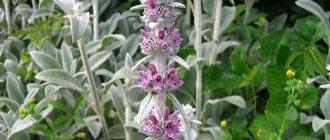Author: Elena N. https://floristics.info/ru/index.php?option=com_contact&view=contact&id=19 Category: Garden plants Published: February 07, 2019Last edits: November 03, 2020
- How to care
- Dividing the bush
- Shelter of a tree peony for the winter
The tree peony is a long-lived plant: it lives on average for a century or a century and a half, but in Asia there are specimens that are half a thousand years old. For the Chinese, the peony flower is a symbol of the awakening of life. Unfortunately, flowering does not last very long, but if you plant several plants with different flowering periods on the site, this period can be significantly increased. The tree peony is cold-resistant, but even if it happens to freeze in winter, the plant quickly recovers in the spring. From our article you can find out:
- what is the difference between a tree peony and a herbaceous one?
- how and when is the best time to plant a peony;
- how to care for the plant and how to prepare it for wintering.
Planting and caring for tree peonies
- Planting: from mid-August to late September.
- Flowering: April-May.
- Lighting: bright sunlight, light partial shade.
- Soil: fertile loam.
- Watering: twice a month, 6-7 liters of water for each bush, in extreme heat - more frequent watering; from August, watering is gradually stopped.
- Fertilizing: at the beginning of the growing season - with nitrogen fertilizer, during the budding period - with potassium-phosphorus fertilizer, during the flowering period - with a full complex.
- Pruning: annually in spring.
- Reproduction: by dividing the bush, cuttings, layering, grafting.
- Pests: aphids, caterpillars.
- Diseases: gray rot, brown spot, root rot.
Read more about growing tree peonies below.
Tree peony flower , or subshrub, is a species of hybrid plants of the genus Peony of the Peony family. Some scientists argue that this is not even a species, but simply a group of varieties and forms of hybrid origin, of which there are more than five hundred in the world today, and most of them grow in China. The tree peony flower is the product of Chinese breeders, although Japanese flower growers enthusiastically began cultivating this plant as soon as it appeared on the territory of their islands during the Tang Dynasty. Tree peonies were brought to Europe at the end of the 18th century and received absolute recognition from both professional flower growers and flower lovers.
conclusions
- Tree peonies decorate the area and do not require special care if planted correctly at the beginning.
- Transplantation and propagation are the most difficult processes in breeding shrub peonies.
- There are several ways to propagate the plant. The most reliable of them is vaccination.
- Tree peony is available in a huge number of varieties of different sizes, shapes and shades. Every gardener will be able to choose a flower to his liking or create a whole composition from them.
Botanical description
The plant is a deciduous shrub, reaching a height of one and a half or two meters. Stems are light brown, thick, erect. They do not die off every autumn, like the stems of the herbaceous peony, but grow every year, gradually turning the plant into a hemispherical bush. The leaves of the tree peony are openwork, double-pinnate, ornamental. The flowers are very large - from 12 cm in diameter to 20 cm, or even more - located at the ends of the shoots. They come in single, semi-double, double, and various colors - yellow, white, pink, purple, crimson, even two-color.
The older the bush gets, the more flowers bloom on it. The tree peony begins to bloom half a month earlier than the herbaceous peony and blooms for two to three weeks. Tree peonies are cold-resistant.
- Calendula: growing in the garden, types, properties
Planting tree peonies
How to plant
Tree peony is planted in the fall, from mid-August to the end of September. The process of planting any flower is preceded by choosing the place where it will grow. In the case of tree peonies, preference is given to sunny areas located at some elevation and away from buildings and large trees, so that the peony does not have to be in their shade. The soil should be loamy, so clay, humus, peat and turf soil will have to be added to the sandy soil. Clay soil must be improved with sand and organic fertilizers.
These are very important points, since the lifespan of the plant depends on them, and tree peonies can grow in one place for up to a hundred years.
Autumn planting
In the case of low groundwater, a hole for the peony is dug in the form of a cone, with a diameter at the surface of 70 cm and the same depth. At the bottom of the hole, place a layer of broken brick, gravel or sand 25-30 cm thick. If the soil is acidic, add 200-300 g of bone meal or lime, then pour the soil into a cone, place the plant on it and pour a lot of water so that the roots straighten out in it. peony After the water is absorbed into the soil, the hole is covered with earth so that the root collar is at surface level. If you are planting several specimens, place tree peony seedlings no closer than 1.5-2 m from each other.
Growing from seeds
A plant grown from seeds, under a successful combination of circumstances, will be able to bloom only 5-6 years after planting; in addition, tree peony seeds, due to the underdevelopment of the embryo, require mandatory stratification, and during long-term storage they generally lose their germination capacity. Stratification is carried out in two stages: first warm, then cold. But even performing these difficult manipulations will not guarantee that your efforts will be crowned with success.
Selection of seedlings
How to propagate a tree flower? Peonies are propagated by dividing the root system or by layering. Propagation by cuttings is also possible, but only rooted seedlings are sold in stores. You can root a cutting at home if you have at least one parent plant.
The purchased planting material can be of two types. With open or closed rhizome. A seedling with an open rhizome is placed in a package, while its root system is outside the ground. If the roots of the seedling are in the ground, it is a planting material with a closed rhizome. Such specimens may have a developing aerial part.
Purchased seedlings may have different root systems. If the plant is grafted, then its roots will be powerful and black, but if the planting material was obtained by layering, it will have thin light roots. The difference between these seedlings is that the first one will bloom the next year, and the second one a few years after planting. A more detailed description of the flowering period is usually indicated on the packaging.
Note! When purchasing planting material with thin roots, you need to pay attention to the number of buds, there should be at least 5 of them, and the length of the seedling itself should not be less than 25 cm. Growing short seedlings will not be successful.
Caring for tree peonies
How to care
If you don’t know how to care for tree peonies, care for them as you would for herbaceous peonies: water with the same frequency and intensity, loosen the soil after watering, remove weeds - nothing complicated. Let us remind you: pour 6-7 liters of water under each bush twice a month, water more often in extreme heat, and in August gradually reduce watering until it stops completely. After watering, loosen the soil around the bush within a radius of half a meter, but no deeper than 5 cm, remove weeds, if any, and lightly mulch the soil around the bush with humus.
Top dressing
You need to know that tree peonies are record holders for potassium and nitrogen consumption among flowering plants. At the beginning of the growing season, they require fertilizing with nitrogen, during the formation of buds and until the end of the growing season they need a large amount of potassium and phosphorus, and during the flowering period, nitrogen must again be added to potassium and phosphorus. Just remember that it is better to underfeed the plant with nitrogen than to develop a predisposition to gray mold by overdosing this element. Before applying fertilizers, water the soil generously: this will protect the peony roots from burning.
- Perennials are the best choice for creating a blooming garden
Trimming
Every spring, even before the start of the growing season, prune the peony bushes: remove the withered shoots, shorten the old ones to 10 cm. Every twenty years, Chinese flower growers prune the peony bushes almost to the surface of the soil in order to rejuvenate the plants by awakening adventitious buds at the base of the shoots. And we recommend cutting the shoots to the upper axillary point so that your peony blooms more abundantly next year.
The length of its life depends on how you trim the tree peony bush. Typically, peonies live for a hundred years, or even more: in China, protected by law and specialists, five-hundred-year-old specimens of tree peonies grow safely.
Transfer
The tree peony undergoes transplantation very painfully; sometimes strong plants, after changing their location, get sick and wither for several years and cannot recover in any way. When replanting, try to injure the root system of the plant as little as possible - dig it up with a lump of earth, which you then carefully wash off with a stream of water. Inspect the roots, remove diseased ones, shorten too long ones, treat the sections with a one percent solution of potassium permanganate and sprinkle with crushed coal.
If you want to propagate a peony, divide the bush into sections by stretching the parts to the sides at the root collar. If you had to undergo surgery, process the sections. Before planting, immerse each division, which must have several replacement buds and roots, in a clay mash for half an hour.
How to care
Tree peonies are unpretentious in care until the first shoots. For young shrubs, one watering every two weeks is enough. The need for water increases only during dry periods. From 6 to 10 liters of water are poured at a time depending on the condition of the soil.
Top dressing
When the peony produces its first shoots, it is necessary to feed it with nitrophosphate fertilizer (100 g per bush). The same support will be required for swelling of the kidneys. Afterwards, once a week the bush is watered with diluted ash. After flowering is completed, superphosphate is added to the soil. When the leaves are dropped, the roots are covered with peat.
Expert opinion
Mikheeva Tamara Gennadievna
Dedicates most of his time to flower beds in his garden and landscape design
Ask a Question
All fertilizing is applied only to moist soil with or after watering. Dry roots run the risk of being burned by chemical elements. It is better not to use nitrogen fertilizers, since they often cause gray rot.
Trimming
Every spring, tree peonies are removed from dry, broken branches, old shoots and leaves. Also, after flowering ends, the seed heads with the tops of the branches are cut off.
General trimming of tree peonies must be done every 20 years. Chinese breeders have found that the plant can be kept young by cutting shoots down to the ground. In this way, new resources are produced for the buds of future inflorescences.
Protection from pests and diseases
This class of peonies is resistant to diseases at a young age. However, transplanted or old shoots are susceptible to misfortune.
The main problem is gray rot. Because of it, a plaque forms that interferes with breathing, the plant begins to thin out and may die. A solution of potassium permanganate or copper sulfate is used as a medicine. Damaged parts are cut off and burned to prevent the spread of infection.
To prevent insects and diseases (brown spots) on the leaves, the bushes are sprayed with Bordeaux mixture according to the instructions on the package. Damaged branches and foliage are also removed.
Seasonal preparation
In autumn, peonies need to be prepared for the winter.
Tree peonies tolerate frost well, but do not like autumn dampness. In the warm autumn, the shoots continue to grow, not having time to fall asleep for the winter. In the northwestern regions, the middle zone, the flower must be prepared for hibernation.
From August, they stop watering, install rain shelters, loosen the soil and cover the roots with peat and humus (at least 1 bucket per bush).
In October, the leaves are cut off from 2/3 of the length of the shoots, the branches are tied up and covered with special bags or sacks. They are not tied at the bottom to allow air to pass through.
After wintering, spring preparation occurs. At the end of April or May (depending on the region), frozen buds are cut off. Particularly damaged shoots are cut back to the first healthy bud.
Transfer
Tree peonies are extremely sensitive to transplants!
After changing the “address”, the flower often cannot gain strength for several years or does not survive at all. Experts advise not to touch the bush unless absolutely necessary.
If relocation of the plant cannot be avoided, act extremely carefully according to the algorithm:
- Dig up the plant . Carefully go around the root, leaving a decent layer of soil on it. Then gradually wash off the soil with a weak stream of running water.
- Inspect the roots . Trim diseased and overly elongated areas, spray the “wounds” with a 1% solution of potassium permanganate, and sprinkle with charcoal.
- Divide the roots . This stage is necessary only for further reproduction. Otherwise it is skipped. Buds and developed roots should remain on each shoot.
- Clay bath . Before planting in a new hole, place the roots in a clay solution for half an hour. This will prevent rotting.
Further actions are similar to the initial planting.
Propagation of tree peonies
Dividing the bush
Actually, we just talked about this, all that remains is to add that it is best to divide for propagation bushes that are 5-6 years old and this should be done in August. Planting of the cuttings is carried out in the manner already described.
Cuttings
Cuttings for this method of propagation need to be semi-lignified, and they are cut in the second half of June: the bud with the leaf plate and part of the shoot wood are separated. The leaf is cut in half, the cuttings are stuck into containers with a mixture of sand and peat to a depth of 1.5 cm, covered with glass or film, regularly watered and sprayed. At the end of September they are planted in individual pots and kept in a greenhouse until spring. When peonies begin to grow, they can be planted in open ground.
Reproduction by layering
The duration of the reproduction process using this method is two years. In May, before flowering begins, select developed shoots, carefully bend them to the ground, having previously made a cut on the side facing the soil, treated it with growth substance and inserted a peg into it, and dig in the branch with a layer of soil of 8-10 cm. Moisten the soil above layering when you water the peony. In September, when the roots appear, the shoot is separated from the bush and planted in the ground in a permanent place.
- Field ash: working on mistakes
Peony can also be propagated by air layering: an incision is made on the shoot, it is wrapped in damp moss, and then in a film, which is hermetically sealed. Roots will appear by the end of summer. The method is as simple as it is ineffective.
Grafting peonies
This is the most common and most reliable method of industrial propagation of peonies. But it can also be used in a private garden. The grafting is carried out on the roots of the herbaceous peony: in early August, cuttings with two buds of the tree peony are prepared, which must be propagated; the lower part of the cutting is sharpened to a wedge and tightly inserted into a specially made wedge-shaped groove in the root of the herbaceous peony. The place where the cutting enters the root is tightly wrapped with film.
Grafted peonies are placed in a box with damp sawdust and stored in the shade. After a month, the rooted cuttings are planted in a container so that the lower eye is immersed in the soil by 5-7 cm, and placed in a greenhouse. A grafted peony is grown for one and a half to two years.
Storage before planting
Seedlings can be purchased all year round. Before permanent planting, intermediate planting in a container of at least 5 liters is permissible. Holes are made in the bottom of the “pot,” drainage is placed, and non-acidic soil is poured. Individuals with a closed root system are stored in the original container.
The temperature in the room should be maintained close to zero (with variations in the plus range). Balconies, basements, loggia are suitable for these purposes with moderate humidity. In winter, you can lightly bury the exposed roots in the snow. Watering is done rarely, not allowing the soil to dry out. In this way, the roots are kept from premature growth.
If it was not possible to contain the roots, after reaching 20 cm of growth, the seedling is taken to a brighter room. Maintain infrequent watering and low air temperatures. 1-2 months before planting, the container is moved to a shady, windless corner of the site for hardening. Then they are planted in the soil.
Pests and diseases
Tree peonies are not known for their pain, but sometimes they also have health problems. Those weakened by transplantation and old bushes are especially susceptible to diseases. The most dangerous thing is gray rot, which can be combated by spraying plants with a solution of potassium permanganate at the rate of 3 g per 10 liters of water. You can spray with a six to seven percent solution of copper sulfate. But rotting stems must be removed and burned.
Sometimes tree peonies suffer from brown spot. The affected leaves should be removed and burned so that the infection does not spread to other plants, and the bush should be sprayed with a one percent solution of Bordeaux mixture.
Why doesn't it bloom
The lack of flowering may indicate improper care of the flower or that it is affected by various diseases.
Reasons for the lack of flowering of the bush:
- untimely planting;
- soil with high acidity;
- frequent planting of flowers or other types of plants near bushes;
- incorrect depth of the planting hole;
- lack of nutrients.
Also, flowering does not occur if the shrub is affected by gray mold, rust disease, cladosporiosis or brown spot. Diseases occur during periods of heavy rain or when the plant is not properly cared for.
To restore the development of buds, all of the above reasons should be excluded and peony care should be normalized.
Note! If buds form but do not bloom, the reason may be that the plant is depleted by ants that feed on the sap of the bush.
Tree peony after flowering
The tree peony has faded - what to do? Once the peony has finished blooming, cut back the spent shoots to the top axillary point, as they will die anyway. In the fall, before the dormant period, feed the plants: add 300 g of wood ash and 200 g of bone meal under each bush, then carefully seal the soil.
How to plant
Seedlings with a closed root system (sold in a container) can be moved into the ground in spring, summer and autumn. Grafted specimens produce flowers in the same season.
Open-rooted seedlings (bought without a container) are best placed on the site in late summer - early autumn. If you plant such peonies in the spring, the growth will go into the green mass, undermining the strength of the roots. The exception is seedlings that were purchased open, but kept in preliminary storage - they had time to form suction shoots on the roots.
Planting step by step
Following the technology will allow peonies to take root as quickly as possible:
- Preparing the pit . 2 weeks before planting, holes are dug about 40 cm in diameter and half a meter deep. Lay 15-30 cm of drainage (you can take sand or pebbles). Leave to settle. Between the pits maintain 1-1.5 m.
- Soil preparation . Fertile soil is stored and equal parts of sand, peat (compost), and humus are mixed into it. Add about 350 g of bone meal.
- Preparing a seedling . Cut off the buds if they have time to form.
- Filling the hole . Part of the soil is poured into the prepared hole. A seedling with an open root system is placed on top, the roots are straightened, and soil is poured to the top of the hole. Seedlings with a closed system are transferred with soil and covered on top. The top of the roots should be just below ground level.
- Completion of landing . Each bush is watered with 5 liters of water with or without fertilizer. Gently compact the surface of the earth. Compact the neck of the seedling with peat or humus to a depth of 3-4 cm.
Fertilizer can also be added to the soil. In this case, it is better to use superphosphate.
Preparing for winter
Shelter of a tree peony for the winter
Despite the fact that tree peonies are cold-resistant and tolerate our winters well, professional flower growers still advise covering them for the winter: peony is not as afraid of frost as early spring thaws, during which peony buds may wake up uncovered by snow or covering material, and As a rule, frosts following a thaw can destroy a plant that has begun to grow. Therefore, in October, tie up the shoots, mulch the tree trunk circle with peat, and with the onset of cold weather, cover the plant by building a hut over it from spruce branches, leaves, a thick layer of crushed bark, or simply with jute bags, so that the wintering of the tree peony goes smoothly.
Types and varieties of tree peonies
The basis of all cultivated varieties of tree peonies are several natural species: Lemoine peony, as well as yellow peony, Delaway peony, Potanin peony, belonging to the group of semi-shrub peonies. Among the registered varieties of tree peonies, most grow in China. Peony varieties are divided into three groups:
- Chinese-European - varieties with double, large, heavy and therefore drooping flowers. Color – from pale pink to fuchsia;
- Japanese varieties - their flowers are not so large, light, hovering above the bush;
- Hybrids of yellow peony and Delaway peony are the most popular variety group with yellow flowers.
Several varieties of tree peonies popular among gardeners:
- Sisters Kiao - two-color pink inflorescences: one half is dark red, the other is white-cream, flower diameter is 16 cm;
- Sapphire - pale pink flowers with a dark crimson center with a diameter of up to 18 cm, of which there can be up to fifty on a bush at a time;
- Coral altar - two-color crowned flowers of both salmon and white shades with a diameter of up to 20 cm;
- Green Jade - light green bud-shaped flowers make an indelible impression with their originality.











